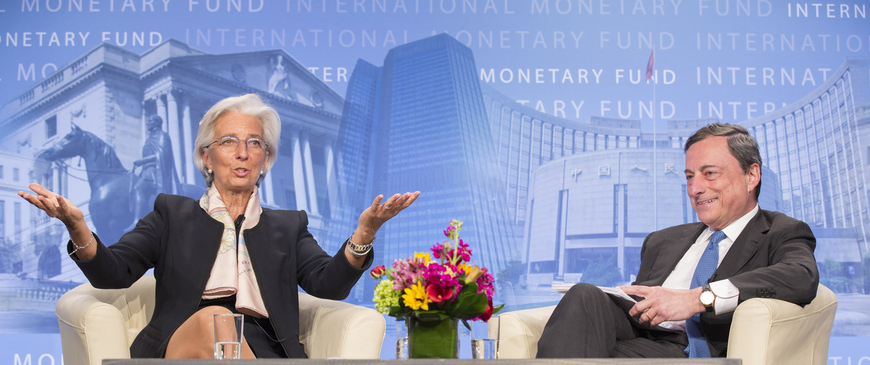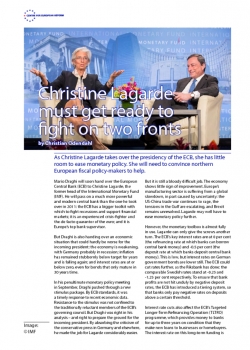
Christine Lagarde must get ready to fight on two fronts
As Christine Lagarde takes over the presidency of the ECB, she has little room to ease monetary policy. She will need to convince northern European fiscal policy-makers to help.
Mario Draghi will soon hand over the European Central Bank (ECB) to Christine Lagarde, the former head of the International Monetary Fund (IMF). He will pass on a much more powerful and modern central bank than the one he took over in 2011: the ECB has a bigger toolkit with which to fight recessions and support financial markets; it is an experienced crisis-fighter and the de facto guarantor of the euro; and it is Europe’s top bank supervisor.
But Draghi is also handing over an economic situation that could hardly be worse for the incoming president: the economy is weakening, with Germany probably in recession; inflation has remained stubbornly below target for years and is falling again; and interest rates are at or below zero, even for bonds that only mature in 30 years time.
In his penultimate monetary policy meeting in September, Draghi pushed through a new stimulus package. By ECB standards, it was a timely response to recent economic data. Resistance to the stimulus was not confined to the traditionally reluctant members of the ECB’s governing council. But Draghi was right in his analysis – and right to prepare the ground for the incoming president. By absorbing the criticism of the conservative press in Germany and elsewhere, he made the job for Lagarde considerably easier.
Lagarde’s main job will be to convince fiscal policy-makers in Berlin, The Hague and elsewhere that fiscal policy has to contribute to growth in Europe.
But it is still a bloody difficult job. The economy shows little sign of improvement. Europe’s manufacturing sector is suffering from a global slowdown, in part caused by uncertainty: the US-China trade war continues to rage, the tensions in the Gulf are escalating, and Brexit remains unresolved. Lagarde may well have to ease monetary policy further.
However, the monetary toolbox is almost fully in use. Lagarde can only give the screws another turn. The ECB’s key interest rates are at 0 per cent (the refinancing rate at which banks can borrow central bank money) and -0.5 per cent (the deposit rate at which banks deposit central bank money). This is low, but interest rates on German government bonds are lower still. The ECB could cut rates further, as the Riksbank has done: the comparable Swedish rates stand at -0.25 and -1.25 per cent respectively. To ensure that bank profits are not hit unduly by negative deposit rates, the ECB has introduced a tiering system, so that banks only pay negative rates on deposits above a certain threshold.
Interest rate cuts also affect the ECB’s Targeted Longer-Term Refinancing Operation (TLTRO) programme, which provides money to banks for up to three years on condition that they make new loans to businesses or homebuyers. The interest rate on this long-term funding is automatically linked to the key interest rates (and the volume of new loans). In September, the ECB made the terms of the programme more attractive for banks.
There is a growing concern that interest rate cuts are ineffective when rates are already low. However, so far at least, banks are passing on most of the lower rates to borrowers. Lower interest rates would also have a dampening effect on the euro, which helps exporters.
The ECB could also buy more assets. In September, it restarted its asset purchase programme (APP) for government, corporate and covered bonds as well as asset-backed securities. By buying assets, the ECB forces their former owners into other investments, for instance more risky corporate bonds. Higher demand for such assets, in turn, reduces the cost of investing for firms.
The monthly pace of asset purchases will be €20 billion per month, which is lower than it was during the previous APP. Lagarde could increase the volume of purchases. It is even conceivable that the ECB could buy shares to make equity funding cheaper for companies. There is no economic limit to the amount of securities the ECB could buy to reach its inflation target.
However, there are political constraints. Foreign assets are taboo as it would be seen to be manipulating the currency. Owning too many government bonds would put the ECB in an awkward position if countries have to restructure their debt. By becoming a major shareholder of private companies, the ECB would have to take decisions on company boards. Lagarde will need to find creative ways around such obstacles.
The major innovation of the latest policy package was to make monetary policy more explicitly ‘state-contingent’: the ECB is now promising to keep policy on the current (or a more expansionary path) until inflation has safely returned to its target. This is an important and long overdue change. For example, it matters today whether the ECB would tolerate an economic boom in the future (that is, raise interest rates rather late) or whether it would act more cautiously, and tighten interest rates at the first sign of increased inflation. So far, the ECB has proved very cautious.
Lagarde could go further, and promise not only that inflation should safely reach 2 per cent, but that it should also overshoot the 2 per cent target for a while to make up for the persistent undershooting over the last five years. In effect, Lagarde would promise to tolerate a boom before starting to tighten. This kind of aggressive communication ensures that interest rate cuts or asset purchases do not fizzle out, as companies and investors no longer expect the ECB to tighten as soon as inflation starts to rise.
Lagarde and her chief economist, Philip Lane, would have to convince an increasingly reluctant governing council to implement such further easing. But even then, there is a good chance that monetary stimulus alone would be insufficient to revive the economy and bring inflation back to 2 per cent.
If Berlin, The Hague and others dislike monetary stimulus and low interest rates, they should spend more. Lagarde will have to make that crystal clear.
In that case, fiscal policy would need to help stimulate the economy, especially in countries such as Germany that have plenty of room to spend more or tax less. But Berlin is unwilling to help the eurozone economy – or in fact, its own, as Germany is among the worst affected by the current downturn. Lagarde will have to provide a stronger challenge to fiscal policy-makers in these countries than Draghi dared.
Europe’s fiscal rules are supposed to make sure that spending is counter-cyclical, that is, that member-states spend more in downturns (and less in boom times), thereby helping the ECB to stabilise the eurozone economy. It turns out, however, that the current rules have failed to encourage counter-cyclical spending. Lagarde needs to push for a major revamp of the rules if she wants fiscal policy to help her. The rules need to be re-designed so that they bring about strongly counter-cyclical fiscal policy in all euro area countries. Lagarde would probably find an ally in the incoming Commission President Ursula von der Leyen.
But the eurozone needs more than that. A common eurozone budget that raised spending when the ECB was reaching its limit would be ideal. Unfortunately, the political agreement that was reached in June turned the idea of a eurozone budget into an item of the general EU budget, made it too small to matter, and stripped it of its main function – stabilising the eurozone economy. Lagarde should ask politicians in Berlin, The Hague and like-minded countries to reconsider their opposition. She should make clear that critics of monetary stimulus have to present an alternative, and that alternative is a strong fiscal response.
Christian Odendahl, Chief economist, Centre for European Reform

